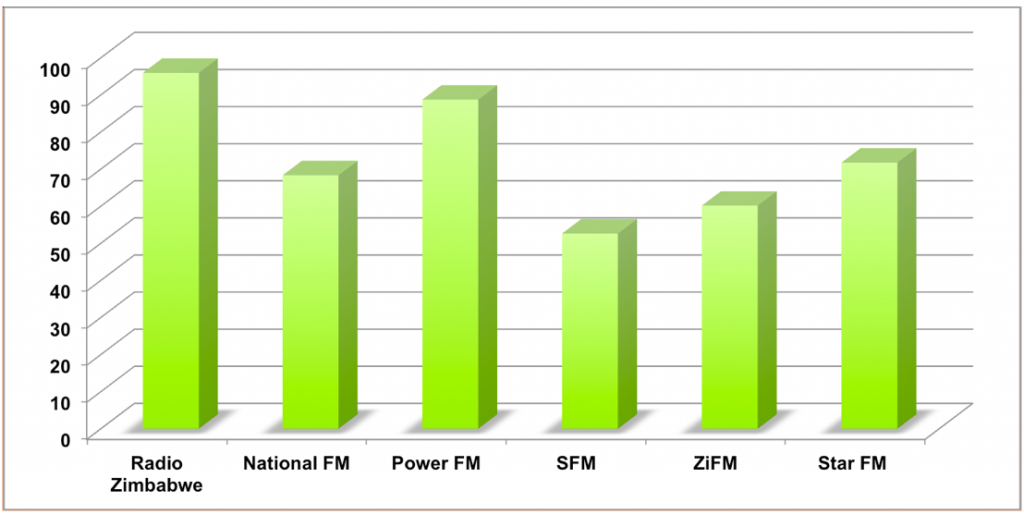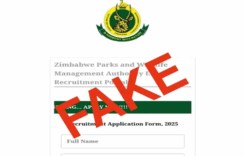Zimbabwe’s mainstream media industry is made up of newspapers divided almost equally between publicly-owned or government-controlled titles and those run by the private sector, and radio and television airwaves dominated by state-driven broadcasters.
While the national constitution guarantees media freedom and freedom of expression, in practice two regulatory (government-appointed) statutory bodies have kept control of both the broadcasting and newspaper publishing sectors through tight licensing requirements.
A government department keeps an eye on the whole media sector.
Zimbabwe Media Commission (ZMC)
The Zimbabwe Media Commission (ZMC) is in charge of registering newspaper publishers, news service agencies and accrediting journalists.
The commission draws its powers from a controversial law which critics say impedes rather than facilitates press freedom despite being called Access to Information and Protection of Privacy Act (AIPPA).
Over the last 15 years, AIPPA has been used by the state to arrest journalists on charges of publishing falsehoods, to ban some publications and to deny, or make it hard, for media houses to get registration.
Broadcasting Authority of Zimbabwe (BAZ)
The Broadcasting Authority of Zimbabwe (BAZ) has control over the licensing of radio and television stations.
Despite pressure at home and from abroad, critics say Zimbabwe’s ruling ZANU-PF party since independence in 1980 has resisted pressure to open up radio space to private players beyond a handful trusted by the party, and to date retains the Zimbabwe Broadcasting Corporation (ZBC)’s near monopoly in the national television area.
Media, Information and Broadcasting Services
The government maintains a wide policy oversight role on the media sector, currently through the Ministry of Media, Information and Broadcasting Services.
Besides being in charge of both the legal instruments AIPPA and BAZ, the Ministry of Media, Information and Broadcasting Services also acts as the government’s main information dissemination agency.
Public frustration
In the last 10 years, a number of reports, including annual African Media Barometers, have concluded that Zimbabwe’s Media was weak in critical areas of accuracy, balance and fairness in news reporting.
In different words, they said Zimbabweans were frustrated by having to seek multiple sources particularly for political news.
A government-sponsored Information Media Panel of Inquiry (IMPI) recommended in 2015 measures to improve professionalism in the Zimbabwean journalism sector and the refocusing of the media sector in meeting public expectations.
Social Media Explosion
Outside and alongside Zimbabwe’s mainstream media sector, information technology has seen an explosion of social media news and information websites run by individuals, organizations and corporates based in and outside Zimbabwe.
The platforms vary in quality and focus, cover a wide range of issues and are subject to the global debate over reliability and the phenomenon of fake news.
Media Lobby Organisations
There are at least a dozen Zimbabwean media representative and lobby organisations working around a range of issues, including law reform, freedom of expression and access to information, professionalism and self-regulation, labour and welfare and gender and marginalisation.
A majority of these membership-based groups get technical and financial assistance from Western countries and international aid organisations.
Broadcast media in Zimbabwe
Summary
Four state-owned Radio Stations
Two privately-owned national commercial radio stations
Eight privately-owned local commercial radio stations with provincial coverage
Twenty community radio initiatives spread around the country
One state-owned TV station
One privately-owned regional satellite TV station
TYPES OF LICENSES OFFERED IN ZIMBABWE
Radio
Zimbabwe offers the following broadcast licenses
- Public broadcasting
- Commercial broadcasting service,
- Community Broadcasting Service,
- Rail casting Service
- Road casting service.
Television
- Public Broadcasting
- Subscription cable broadcasting service,
- Subscription broadcasting service,
- Subscription narrowcasting service,
- Open narrowcasting service,
- Webcasting, Datacasting service,
- Video on demand service
- Content distribution service.
TELEVISION
Zimbabwe has one Public Service Broadcaster – ZTV
2 Satellite TV stations – Multichoice Zimbabwe and Kwese TV
RADIO
Zimbabwe has 14 licensed radio stations and 20 radio initiatives that are yet to be licensed.
State controlled radio stations
Zimbabwe Broadcasting Corporation owns national stations that include:
- Power FM
- SFM
- Radio Zimbabwe
- National FM.
National Commercial radio stations
- Star FM owned by Zimpapers
- ZiFM owned by AB Communications
Local Provincial radio stations
Zimpapers owns:
- CapiTalk radio
- Nyami Nyami Fm
- Diamond FM
AB Communications owns
- 98.4 FM
- Hevoi FM
Ray of Hope owns
- Ya FM
Fair Talk Communications owns
- Skyz Fm
- Breeze
The print media in Zimbabwe has eleven (11) government owned and Fourteen (14) privately owned newspapers and eight (8) provincial newspapers.
| Public | Private | Community |
| The Herald | NewsDay | Pungwe |
| Chronicle | Daily News | Nehanda Guardian |
| The Sunday Mail | The Zimbabwe Independent | Ilanga |
| Sunday News | The Standard | Indosakusa |
| B-Metro | The Weekend Post | Mashonaland West Telegraph |
| H-Metro | The Financial Gazette | The Times |
| The Manica Post | Southern Eye | Chaminuka |
| Kwayedza | Tell Zimbabwe | Masvingo Star |
| Umthunywa | The Patriot | |
| Business Weekly | The Mirror | |
| Suburban | Business Connect | |
| Harare News | ||
| Midlands Observer | ||
| The People’s Voice |
|
According to the constitution of Zimbabwe
Electoral Act and Reforms
Section 3 C) every political party has the right to operate freely within law, to put up or sponsor one or more candidates in every election, to campaign freely within law and to have reasonable access to the media.
160G Access to public broadcasting media
(1) Public broadcasters shall give such free access to their broadcasting services as may be prescribed…and a fair and balanced allocation of time between each political party and independent candidate;
Political advertising in broadcasting and print media
(1) A broadcaster or print publisher shall not be obliged, subject to section 160G, to publish any advertisement by or on behalf of a political party or candidate contesting an election, but if the broadcaster or publisher is prepared to publish any such advertisement
(a) it shall offer the same terms and conditions of publication, without discrimination, to all the political parties and candidates contesting the election.
160J Conduct of news media during election period
During an election period broadcasters and print publishers shall ensure that—
(a) all political parties and candidates are treated equitably in their news media, in regard to the extent, timing and prominence of the coverage accorded to them;
(b) reports on the election in their news media are factually accurate, complete and fair;
(c) a clear distinction is made in their news) a clear distinction is made in their news media between factual reporting on the election and editorial
comment on it;
(d) Inaccuracies in reports on the election in their news media are rectified without delay and with due
prominence;
(e) political parties and candidates are afforded a reasonable right of reply to any allegations made in their
news media that are claimed by the political parties or candidates concerned to be false;
(f) their news media do not promote political parties or candidates that encourage violence or hatred against
any class of persons in Zimbabwe;
- g) their news media avoid language that—
(i) encourages racial, ethnic or religious prejudice or hatred; or
(ii) encourages or incites violence; or
(iii) is likely to lead to undue public contempt towards any political party, candidate or class of person in Zimbabwe. Political parties or candidates that encourage violence or hatred against any class of persons in Zimbabwe.
Broadcasting of political matter
- (1) If, during an election period, a broadcaster broadcasts election matter, the broadcaster shall give reasonable and equal opportunities for the broadcasting of election matter to all political parties contesting the election.
- (1) if an election is to be held and a broadcaster has a licence that has a licence area; and the licence area overlaps, contains or is contained in the area of Zimbabwe to which the election relates; the broadcaster shall not broadcast an election advertisement in relation to the election during the relevant period.
- (2) If an election is to be held and a broadcaster has a licence that does not have a licence area; and the broadcasting service under the licence is normally received in the area of Zimbabwe to which the election relates; the broadcaster shall not broadcast an election advertisement in relation to the election during the relevant period as part of that service.
- (1) If a broadcaster broadcasts political matter at the request of another person, the broadcaster must, immediately afterwards, cause the required particulars in relation to the matter to be announced in a form approved in writing by the Authority.
Audience/ Market statistics
There is an estimated 9,867,871 listeners and readers across the country when data is referred to the World Population Prospects 2017 revision, targeting adults between 15 years and above.
Radio
Radio Zimbabwe is the most listened to radio station in Zimbabwe with 43 percent share of the national audience, according to the latest Zimbabwe All Media Product Survey. Star FM is second on national listenership with 30%, Power FM 17%, ZiFM 12% and National FM comes last with 9% of the total listenership. . Other radio stations that have a share are Diamond FM (9%), Yaa FM (6%), Hevoi (3%), SFM (3%), and VOA (3%).
The Herald continues to be the most read daily newspaper for the past half-decade. Zimpapers, which are partly government owned newspapers, have the widest reach. However, for private daily newspapers Newsday is the top most read newspaper in Zimbabwe. According to a survey by ZAMPS, Herald tops the circulation chart with (44%), H-metro (30%), Newsday 28, Daily News (27%) and Chronicle (24%).
For weekly papers, The Sunday mail dominates with 27% of the total readership followed by Kwayedza with 15%. Other papers include in the survey are B-Metro (11%), Manica Post (8%), Sunday News (7%), The Standard (5%), Zimbabwe Independent (3%), Daily News on Sunday (3%) and Financial Gazette (2%).
Who is the most influential radio player?
Research statistics based on ZAMPS report 2016-2017 and Media Monitors radio mapping report.
Radio Listenership
According to the Zamps report, Radio Zimbabwe is the most listened to station nationwide and has a huge influence nationwide. In broadcasting, Zimpapers’ radio station Star FM continues to dominate urban listenership, increasing its reach by a point with a 51 percent grip on the market up from 50 percent in the last survey. ZiFM follows with 28 percent listenership while Radio Zimbabwe recorded a 26 percent grip with Power FM, SFM and National FM bringing up the rear.
Language
English and Shona are the most commonly used broadcast languages; used on nine different
stations while National FM has the most diverse number of languages used as it broadcasts in
eleven languages.
News on radio
Nine percent of programming time is dedicated to news by all the radio stations. SFM allocates the most time to news bulletins; the station airs news bulletins on the top of every hour. The station therefore has 24 news bulletins, with three – thirty minute news bulletins at 6am, 6pm and 8pm. Power FM is the only other station with 24 hour news bulletins, although the total amount of time spent on news is less.
Reach in terms of transmission
Of the ZBC radio stations, Radio Zimbabwe’s coverage is listed as +80 percent, and 70 percent for the others. ZiFM says its geographical coverage reaches 80 percent. Overall geographical coverage for radio is 72.8 percent within Zimbabwe. This figure however fluctuates from station to station with Radio Zimbabwe being the most accessible at 95.8 percent reception. It is followed by Power FM, which has a reception in of 88.7 percent of surveyed regions. SFM has the lowest coverage at 52.6 percent.

Factsheet compiled by Cris Chinaka largely from a brief by Media Monitors of Zimbabwe.
Do you want to use our content? Click Here












Anonymous
- Edit
wonderful document